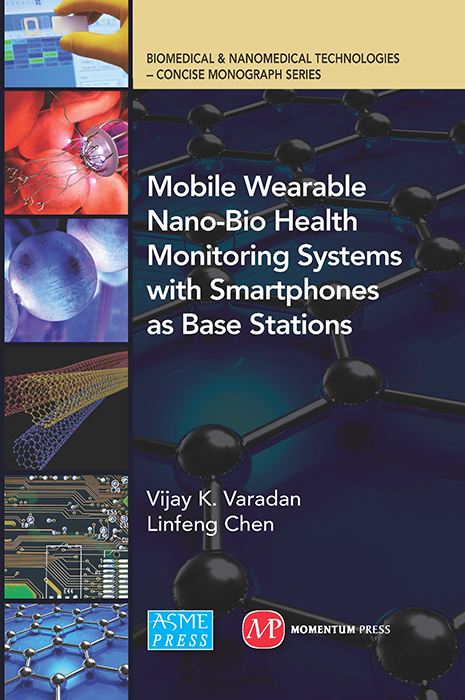Researchers Publish Book on Wireless Health-Monitoring Systems

Mobile Wearable Nano-Bio Health Monitoring Systems with Smartphones as Base Stations discusses the development and application of mobile, wireless health-monitoring systems.
FAYETTEVILLE, Ark. – A new book by Vijay Varadan, Distinguished Professor of electrical engineering at the University of Arkansas and U of A research scientist Linfeng Chen, discusses the development and application of mobile, wireless health-monitoring systems. The book, published by The American Society of Mechanical Engineers, covers the history and evolution of textile-based sensors, health monitoring systems and the use of smart phones and other mobile devices for health care applications.
In these mobile systems, nanomaterials-based biosensors are used to measure physiological signals, such as electrocardiogram (ECG), electroencephalogram, electromyogram and electrooculogram. The physiological signals are filtered, amplified and transmitted to a remote storage server, using smart phones as the base stations. The system uses cloud-computing resources for complex computations, such as feature extraction and automatic diagnosis. The information, stored in remote servers, can be instantly accessed by health care providers or the user, and medical advice can be sent to patients through the wireless communication system.
In recent years Varadan and his research colleagues at the University of Arkansas have focused on developing textiles embedded with nanostructured sensors that gather health information and use smart phones to communicate the information to computers and other devices. Earlier this year, the researchers announced that they had developed a wireless health-monitoring system integrated into a conventional sports bra for women and a shirt for men. The system gathers physiological information, regardless of location, and communicates that information in real time to a physician, hospital or the patient. In addition to the sensors woven into the garment, the system includes a lightweight and wireless module that snaps onto the garment and communicates with software that relies on a smart phone to collect information, compress it and send it over a variety of wireless networks.
The system monitors blood pressure, body temperature, respiratory rate, oxygen consumption, some neural activity and all the readings provided by a conventional ECG, including the ability to display inverted T waves, which indicate the onset of cardiac arrest. The system does not require a cuff or any extra accessories to measure blood pressure and could therefore replace conventional blood-pressure monitors. It could also replace the cumbersome combination of ECG sensors and wires attached to patients while they walk on treadmills.
Varadan holds the College of Engineering’s Twenty-First Century Endowed Chair in Nano- and Bio-Technologies and Medicine and the college’s Chair in Microelectronics and High Density Electronics. He is director of the High Density Electronics Center and the Center for Wireless Nano-, Bio- and Info-Tech Sensors and Systems, which is funded by the National Science Foundation.
Contacts
Vijay Varadan, distinguished professor, electrical engineering
College of Engineering
479-575-2873,
vjvesm@uark.edu
Matt McGowan, science and research communications officer
University Relations
479-575-4246,
dmcgowa@uark.edu
Headlines
Four Students Named Goldwater Scholars; Two Earn Udall Honorable Mentions
Four U of A students have received the prestigious Goldwater Scholarship, an award for top students in mathematics, science, and engineering.
Cross-Campus Collaboration Culminates in New Outdoor Geological Installation
Grand opening event to celebrate the new GeoLab installation at the U of A’s Gearhart Hall courtyard is set for May 3. The installation will be open to the public year-round.
First Students to Use Online Degree to Hone Nursing Leadership, Elevate Patient Care
Hanna Baxendale and Wendi Kimbrell will begin coursework in the Doctor of Nursing Practice-Executive Master of Business Administration program offered by the Eleanor Mann School of Nursing and Walton College.
Join the Office for Sustainability on a Final Cruise to Campus
Cruise to Campus Wednesdays have fostered a gathering space for individuals interested in biking to campus. Drop by the Old Main Lawn from 7:30-10 a.m. Wednesday for coffee, something to eat and conversation.
Fay Jones School Student Ambassador Program Gives Voice to Design Students
The student ambassador program at the Fay Jones School of Architecture and Design is built to connect top design students with their school, its alumni, its future students and others inside and outside the school.




